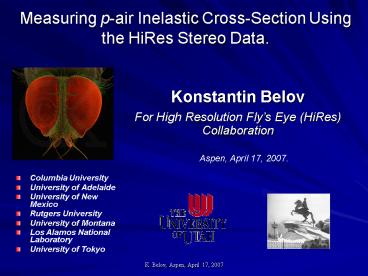Konstantin Belov PowerPoint PPT Presentation
1 / 21
Title: Konstantin Belov
1
Measuring p-air Inelastic Cross-Section Using the
HiRes Stereo Data.
- Konstantin Belov
- For High Resolution Flys Eye (HiRes)
Collaboration
Aspen, April 17, 2007.
- Columbia University
- University of Adelaide
- University of New Mexico
- Rutgers University
- University of Montana
- Los Alamos National Laboratory
- University of Tokyo
2
Outline
- Measuring Cross-Section using Cosmic Rays
- Strong Interaction Model Dependence
- HiRes Stereo Data Reconstruction
- New HiRes p-air Cross-Section Value
- Experimental measurement of the k-factor
- Heavier Component (Fe and He) and Gamma Ray
Influence - Conclusion.
3
Observable Shower Profile.
4
Measured shower profile.
Measured shower parameters.
- Event by event
- Xmax in g/cm2
- Total energy of the primary particle
- Arrival direction
- Statistically
- p-air inelastic cross-section
- Mass composition.
5
Xmax distribution - what we can measure.
- MC simulated Xmax distribution at E1018.5 eV.
Corsika 6.003 QGSJET01.
6
MC X1 and X separation
- Interaction length distribution. Corsika 6.003
QGSJET01.
7
X distribution
- X distribution. Corsika 6.003 QGSJET01.
8
Xmax distribution.
- Xmax distribution is considered as a convolution
of X1 and X distributions.
9
QGSJET01, QGSII, SIBYLL2.1
10
X' Fitting parameters.
11
Fitting Functions
12
Data reconstruction at HiRes
- Adaptive sieve fitting algorithm.
- Propagator method.
- Minuit fitter.
- Time-dependent databases
- Gain
- Ontime
- Atmospherics
- Successfully implemented global fit (HiRes1 and
HiRes2 combined fit).
13
Robust profile reconstruction.
HiRes1 fit
Global fit
HiRes2 fit
14
Resolutions with global fit - preliminary.
Minimal quality cuts. Only count events with
global fit. Still work in progress.
15
Data Xmax Distribution
- Only events with global fit are used
- Less tight quality cuts due to more stable
profile reconstruction - Reduced reconstruction bias
- Work in progress systematic errors are not
fully evaluated yet.
Preliminary -
- HiRes
16
HiRes 2007 Measurement.
17
Experimental measurement of the k-factor
- K-factor was used in previous experiments to
measure the p-air inelastic cross-section and was
obtained from MC simulations.
k(exp. Index) / (mean free path)
k 1.21 0.14 - 0.09
18
k from the models
Muniz, Engel, Gaisser, Ortis Stanev
arXivastro-ph/0402092 2004
Pryke arXivastro-ph/0003442 (2000) at 1017 eV
Flys Eye used k 1.6
19
Heavier component influence.
- Fe is cut off by using the deeper portion of the
Xmax distribution - He and gamma has to be taken into account
20
Data Xmax Distribution
- Generate MC showers initiated by p and He
primaries - Run thru a detector simulator program using pure
proton contaminated data sets - Reconstruct the MC data - reconstruction
efficiency for He and proton is very similar - Deconvolute the cross-section.
He influence is statistically insignificant for
He flux up to 10.
21
Conclusions
- Preliminary proton-air inelastic cross-section
value is 460 14 (stat) 39 (sys) 11(sys) mb - Strong interaction models have minimal influence
on the proton-air inelastic cross-section
measurement - The measurement is very stable
- Experimental value of the k-factor is in good
agreement with the newer models - He influence is insignificant for He flux upto
10 - Gamma effect is more significant and is taken
into account as a systematic error.

